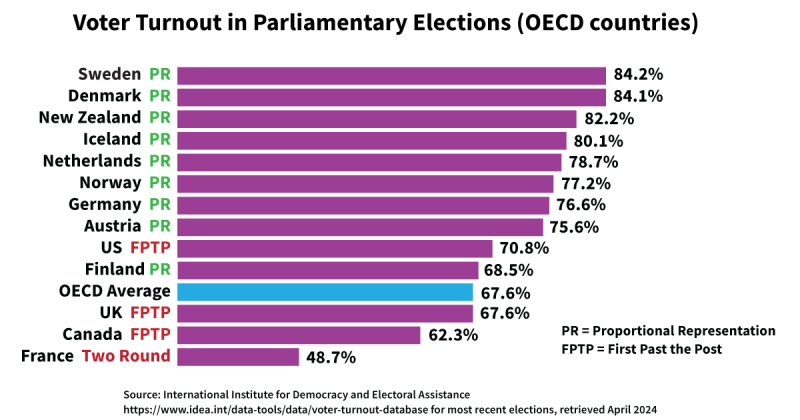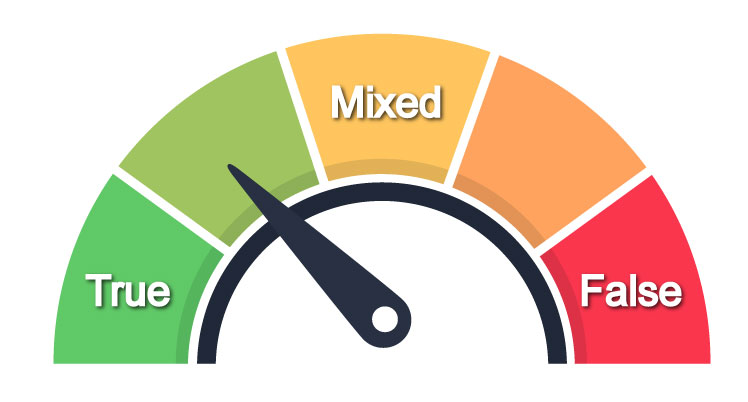
Is voter turnout higher in countries with proportional representation?
Claim: “Voter turnout is higher on average in countries with proportional representation.”
a

Fact Check Summary
The claim above is true.
Research is clear that voter turnout is higher in countries with proportional representation than in countries with “winner-take-all” systems. SEE RESEARCH IN DETAIL IN THE SECTION BELOW.
Why are we including this in a Fact Check?
Sometimes PR proponents go further than this and say that if Canada adopts proportional representation, it will definitely cause more people in Canada to vote.
Then opponents will challenge this.
We can hope that with proportional representation, turnout will increase in Canada. With PR, almost every voter will be able to help elect an MP (votes will really count). Elections will become more competitive, with far fewer “safe seats”.
2020 research by Fred Cutler, Antony Hodgson and Alexandre Rivard of the University of British Columbia concluded that hundreds of thousands of Canadians are not voting now because they know their votes won’t elect anybody.
The truth is, nobody can guarantee the effect of proportional representation on voter turnout in Canada. While countries with PR have higher turnout, evidence on whether a country adopting PR now will increase turnout is now is sparse, simply because most OECD countries began using PR such a long time ago that there is very little “before and after” data to make the comparisons.
Switzerland is an interesting case to look at, because their cantons (like states) adopted proportional representation gradually. over a period of 60 years, 18/25 cantons adopted PR. This allowed researchers to look at the effects of adopting proportional representation over time in the same country. Researchers concluded that adopting PR raised voter turnout by 14%.
When New Zealand adopted PR, they saw an increased turnout in their first election with PR, then the turnout started to decline. This is consistent with a pattern of declining turnout across almost all Western democracies in recent decades, regardless of the voting system. While voter turnout in New Zealand is still around 80%, adopting PR did not cause turnout to increase. Of course it’s impossible to say what the rate of decline would have been if New Zealand had continued to use first past the post.
Voter turnout is higher in countries with proportional representation
- Multiple researchers have found voter turnout is higher in countries with proportional systems:
– Lijphart (2012) looking at 36 democracies over 55 years found turnout to be 7% higher.
– Blais and Carty (1990) – 8% higher
– Norris (1997) – 6-10% higher
– International Democracy and Electoral Assistance (1999) – 12% higher among youth -
Frank and Martínez i Coma (2021) provide the most up-to-date compendium of research results to date and the most comprehensive testing of political, institutional, and socio-economic factors associated with turnout. They find that 10 studies out of 19 on the subject found a statistically significant positive relationship between turnout and PR (Table 1, row 3). Only 1 found a negative relationship.
Frank and Martinez i Coma pursue this line of research further and conduct their own work on the subject, considering 70 different variables in 579 elections in 80 democracies from 1945 to 2014. Testing a wide range of model specifications, they find proportional representation to be a robust predictor of turnout accounting for a 5.2 percentage point boost in turnout.aa
- A study by Gathmann (2019) looked at turnout in Swiss cantons between 1890 and 1950 as eighteen of the twenty-five states switched to proportional representation. She found “the adoption of proportional representation raises voter turnout in elections for cantonal parliaments by on average 14 percentage points. These effects are highly persistent: extending the period of analysis to 2000, I still find that average turnout is 13.6 percentage points higher than under a majoritarian system, suggesting that citizens are consistently more likely to participate in elections under a proportional system.” This study was notable because it compared turnout rates using two systems within the same country.
a - A study in the US compared turnout data for 215 elections in 49 jurisdictions that used either cumulative voting (a semi-proportional system) or plurality voting (first past the post). This study was notable because it also compared turnout rates using two systems within the same country, but more significantly, this study also looked at turnout rates before and after a switch to cumulative voting. Researchers found that a switch to cumulative voting increased turnout by about 5%, an increase that was sustained for the second election.
a - More competitive elections have been shown to be associated with higher turnout. Franklin (2003) found: “In plurality (first past the post) elections, if the average margin of victory increases by 10 percent, turnout will drop by 5.7 percent.”
aaaa - After New Zealand switched from first-past-the-post to proportional representation there was a small increase in voter turnout for the first election with PR, then voter turnout fell in subsequent elections. However, Vowles (2013) found that turnout with PR was higher among youth, and it was higher in ridings that used to be “safe seats” when New Zealand had first-past-the-post.
a - There is no research looking at a significant number of OECD countries that have switched from winner-take-all to proportional systems to assess the impact on voter turnout. This is because most OECD countries have had proportional systems for about 100 years.
References
Blais, Andre and Carty, R.K. (1990). Does proportional representation foster voter turnout? European Journal of Political Research,18: 167-181.
Bowler, S., Brockington, D., and Donovan, T. (2001). Election Systems and Voter Turnout, Experiments in the United States.The Journal of Politics. Vol. 63, No. 3 (Aug., 2001), pp. 902-915
Frank, Richard W. and Ferran Martínez i Coma (2021). “Correlates of Voter Turnout.” Political Behavior, May 11, 2021.
Franklin, Mark (2003). Voter Turnout and the Dynamics of Electoral Competition in Established Democracies Since 1945. Cambridge University Press.
Gathmann, Christina (2019). “Proportional Representation, Political Responsiveness and Child Mortality.” IZA Institute of Labour Economics. IZA Discussion Paper No. 12729. Oct. 2019.
International Institute for Democracy and Electoral Assistance (IDEA, 1999). Youth Voter Participation.
Karp, Jeffrey and Banducci, Susan. The impact of proportional representation on turnout: Evidence from New Zealand. Australian Journal of Political Science, Vol. 34, No. 3, pp. 363-377.
Lijphart, Arend (2012). Patterns of Democracy. Government Forms and Performance in 36 Countries. New Haven, CT: Yale Press.
Norris, Pippa (1997). Choosing Electoral Systems: Proportional, Majoritarian and Mixed Systems. International Political Science Review / Revue internationale de science politique Vol. 18, No. 3, pp. 297-312
Vowles, Jack (2013). “Electoral System Change, Generations, Competitiveness and Turnout in New Zealand, 1963–2005.” British Journal of Political Science, May 31, 2013
